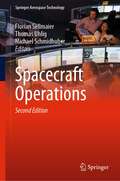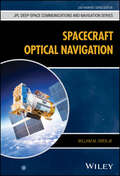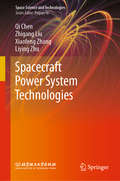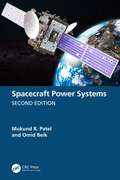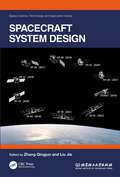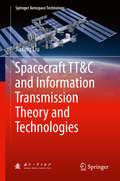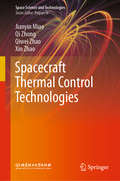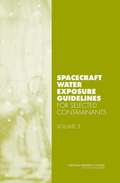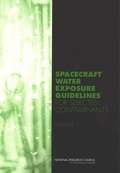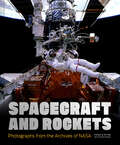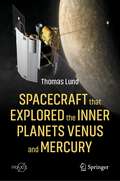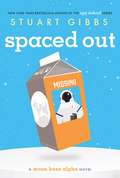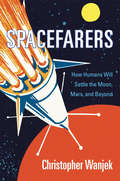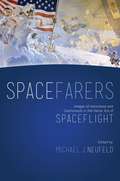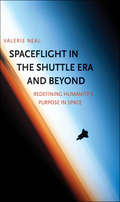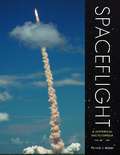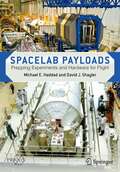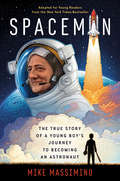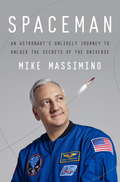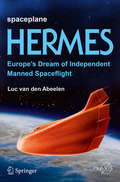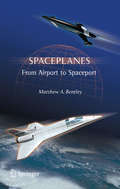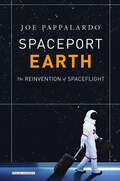- Table View
- List View
Spacecraft Operations (Springer Aerospace Technology)
by Thomas Uhlig Florian Sellmaier Michael SchmidhuberThis book describes the basic concepts of spacecraft operations for both manned and unmanned missions. The first part of the book provides a brief overview of the space segment. The next four parts deal with the classic areas of space flight operations: mission operations, communications and infrastructure, the flight dynamics system, and the mission planning system. This is followed by a part describing the operational tasks of the various subsystems of a classical satellite in Earth orbit. The last part describes the special requirements of other mission types due to the presence of astronauts, the approach of a satellite to another target satellite, or leaving Earth orbit in interplanetary missions and landing on other planets and moons.The 2nd edition is published seven years after the first edition. It contains four new chapters on flight procedures, the human factors, ground station operation, and software and systems. In addition, several chapters have been extensively expanded. The entire book has been brought up to date and the language has been revised.This book is based on the “Spacecraft Operations Course” held at the German Space Operations Center. However, the target audience of this book is not only the participants of the course, but also students of technical and scientific courses, as well as technically interested people who want to gain a deeper understanding of spacecraft operations.
Spacecraft Optical Navigation (JPL Deep-Space Communications and Navigation Series)
by William M. Owen Jr.UNIQUE RESOURCE EXPLORING HOW SPACECRAFT IMAGERY PROVIDES PROFESSIONALS WITH ACCURATE ESTIMATES OF SPACECRAFT TRAJECTORY, WITH REAL-WORLD EXAMPLES AND DETAILED ILLUSTRATIONS Spacecraft Optical Navigation provides detailed information on the planning and analysis of spacecraft imagery to help determine the trajectory of a spacecraft. The author, an experienced engineer within the field, addresses the entirety of celestial targets and explains how a spacecraft captures their imagery. Aimed at professionals within spacecraft navigation, this book provides an extensive introduction and explains the history of optical navigation, reviewing a range of optical methods and presents real world examples throughout. With the use of mathematics, this book discusses everything from the orbits, sizes, and shapes of the bodies being imaged, to the location and properties of salient features on their surfaces. Specific sample topics covered in Spacecraft Optical Navigation include: History of various past spacecraft, including Mariner and Viking, Voyager, Galileo, NEAR Shoemaker, and Cassini, and flight hardware, star catalogs, and stereophotoclinometryCameras, covering the gnomonic projection (and deviations from it), creation of a digital picture, picture flattening, and readout smearsModeling optical navigation observables, covering apparent directions to an object, star, and limbs or terminators, and orientation of camerasObtaining optical navigation observables, covering centerfinding for stars and resolved and unresolved bodies, and using opnav data in orbit determination Spacecraft Optical Navigation is an ideal resource for engineers working in spacecraft navigation and optical navigation, to update their knowledge of the technology and use it in their day-to-day. The text will also benefit researchers working with spacecraft, particularly in navigation, and professors and lecturers teaching graduate aerospace courses.
Spacecraft Power System Technologies (Space Science and Technologies)
by Zhigang Liu Qi Chen Xiaofeng Zhang Liying ZhuThis book provides an introduction to the main design principles, methods, procedures, and development trends in spacecraft power systems. It is divided into nine chapters, the first of which covers the classification and main components of primary power system design and power distribution system design. In turn, Chapters 2 to 4 focus on the spacecraft power system design experience and review the latest typical design cases concerning spacecraft power systems in China. More specifically, these chapters also introduce readers to the topological structure and key technologies used in spacecraft power systems. Chapters 5 to 7 address power system reliability and safety design, risk analysis and control, and in-orbit management in China’s spacecraft engineering projects. The book’s closing chapters provide essential information on new power systems and technologies, such as space nuclear power, micro- and nano-satellite power systems, and space energy interconnection systems. An outlook on future development trends rounds out the coverage.
Spacecraft Power Systems
by Mukund R. Patel Omid BeikThis second edition of Spacecraft Power Systems is a comprehensive coverage of the fundamentals, design trades, components, controls, and operations of spacecraft power systems based on the real-world design and operations of spacecraft that have successfully flown for decades. It also includes emerging high-voltage, high-power systems for in-space propulsion for interplanetary travel. With new and updated chapters, sections, and discussions, the second edition covers up-to-date high-voltage, MW-scale electric propulsion, updated PV and battery systems, spacecraft power components, power electronics, and their architectures and operations. This book also presents the latest in spacecraft design processes and trades, controls, operations, and protection. This book is intended for senior undergraduate and graduate students in mechanical, aerospace, and electrical engineering taking courses in Space Systems, Space Engineering, and Spacecraft Power Systems, as well as for practicing aerospace and power engineers and managers who are designing, developing, and operating spacecraft power systems.
Spacecraft System Design (Space Science, Technology and Application Series)
by Liu JieDrawing on practical engineering experience and latest achievements of space technology in China, this title investigates spacecraft system design and introduces several design methods based on the model development process.A well-established space engineering system with spacecraft as the core is integral to spaceflight activities and missions of entering, exploring, developing and utilizing outer space. This book expounds the key phases in the workflow of spacecraft development, including task analysis, overall plan design, external interface, configuration and assembly design and experimental verification. Subsystems that function as the nuclei of spacecraft design and important aspects in the model development process are then examined, such as orbit design, environmental influence factors, reliability design, dynamics analysis, etc. In addition, it also discusses the digital environment and methods to improve the efficiency of system design.The title will appeal to researchers, students, and especially professionals interested in spacecraft system design and space engineering.
Spacecraft TT&C and Information Transmission Theory and Technologies
by Jiaxing LiuSpacecraft TT&C and Information Transmission Theory and Technologies introduces the basic theory of spacecraft TT&C (telemetry, track and command) and information transmission. Combining TT&C and information transmission, the book presents several technologies for continuous wave radar including measurements for range, range rate and angle, analog and digital information transmissions, telecommand, telemetry, remote sensing and spread spectrum TT&C. For special problems occurred in the channels for TT&C and information transmission, the book represents radio propagation features and its impact on orbit measurement accuracy, and the effects caused by rain attenuation, atmospheric attenuation and multi-path effect, and polarization composition technology. This book can benefit researchers and engineers in the field of spacecraft TT&C and communication systems. Liu Jiaxing is a professor at The 10th Institute of China Electronics Technology Group Corporation.
Spacecraft Thermal Control Technologies (Space Science and Technologies)
by Xin Zhao Jianyin Miao Qi Zhong Qiwei ZhaoThis book presents fundamental theories, design and testing methodologies, and engineering applications concerning spacecraft thermal control systems, helping readers gain a comprehensive understanding of spacecraft thermal control systems and technologies. With abundant design methods, advanced technologies and typical applications to help them grasp the basic concepts and principles of engineering applications, it is mainly intended for engineering and technical staff engaged in spacecraft thermal control areas. The book discusses the thermal environments commonly used for space flight missions, rules and regulations for system design, thermal analysis and simulation, and thermal testing methods, as well as the design and validation of the thermal control systems for Chinese spacecraft, such as the Shenzhou spacecraft and Chang’e Lunar Lander and Rover. It also introduces them to communication and remote sensing satellites and presents advanced thermal control technologies developed in recent years, including heat transfer, heat insulation, heating, refrigeration and thermal sensor technologies. Addressing the design and validation of thermal control systems for various types of Chinese spacecraft, the book offers a valuable theoretical and practical reference guide for researchers and engineers alike.
Spacecraft Water Exposure Guidelines For Selected Contaminants: Volume 3
by National Research Council of the National AcademiesNASA maintains an active interest in the environmental conditions associated with living and working in spacecraft and identifying hazards that might adversely affect the health and well-being of crew members. Despite major engineering advances in controlling the spacecraft environment, some water and air contamination is inevitable. Several hundred chemical species are likely to be found in the closed environment of the spacecraft, and as the frequency, complexity, and duration of human space flight increase, identifying and understanding significant health hazards will become more complicated and more critical for the success of the missions. To protect space crews from contaminants in potable and hygiene water, NASA requested that the National Research Council NRC provide guidance on how to develop water exposure guidelines and subsequently review NASA's development of the exposure guidelines for specific chemicals. This book presents spacecraft water exposure guidelines (SWEGs) for antimony, benzene, ethylene glycol, methanol, methyl ethyl ketone, and propylene glycol.
Spacecraft Water Exposure Guidelines: For Selected Contaminants
by National Research Council of the National AcademiesThe International Space Station is a closed and complex environment, so some contamination of its internal atmosphere and water system is expected. To protect space crews from contaminants in potable and hygiene water, the National Aeronautics and Space Administration (NASA) requested that the National Research Council (NRC) provide guidance on how to develop water exposure guidelines and review NASA’s development of the exposure guidelines for specific chemicals. NASA selects water contaminants for which spacecraft water exposure guidelines (SWEGs) will be established; this involves identifying toxicity effects relevant to astronauts and calculating exposure concentrations on the basis of those end points. SWEGs are established for exposures of 1, 10, 100, and 1,000 days. This report is the second volume in the series, Spacecraft Water Exposure Guidelines for Selected Chemicals. SWEG reports for acetone, alkylamines, ammonia, barium, cadmium, caprolactam, formate, formaldehyde, manganese, total organic carbon, and zinc are included in this report. The committee concludes that the SWEGs developed for these chemicals are scientifically valid based on the data reviewed by NASA and are consistent with the NRC (2000) report, Methods for Developing Spacecraft Water Exposure Guidelines. SWEG reports for additional chemicals will be presented in a subsequent volume.
Spacecraft Water Exposure Guidelines: For Selected Contaminants
by Subcommittee on Spacecraft Exposure GuidelinesTo protect space crews from contaminants in potable and hygiene water, NASA requested that the National Research Council (NRC) provide guidance on how to develop water exposure guidelines and subsequently review NASA’s development of exposure guidelines for specific chemicals.
Spacecraft and Rockets: Photographs from the Archives of NASA (NASA)
by Nirmala Nataraj NASADiscover the remarkable NASA spacecraft that have captured our imaginations for decades.The rockets, rovers, satellites, and space stations that have charted courses into space are depicted in beautiful color images and paired with engaging annotations. Complete with a preface by Bill Nye, this collection perfectly captures the wonder and science of space exploration. From the earliest Saturn and Gemini missions through the modern-day Artemis and HALO ships, these extraordinary spacecraft will fascinate anyone intrigued by science, history, and the mysteries of the beyond. CELEBRATE INNOVATION: Spacecraft and Rockets features fascinating images accompanied by expert explanations of the history and science of space exploration. This book is a unique celebration of the technological advances that have taught us so much about the universe and our place amongst the stars. NASA-APPROVED SPACE BOOK: Bearing the official imprimatur of the legendary space agency, this stellar hardcover volume provides a guided tour through the history of NASA's most exciting innovations and inventions. FOR THE CURIOUS MIND: NASA’s beautifully documented space explorations inspire people of all ages, making this deluxe volume a wonderful gift for science enthusiasts, sci-fi fanatics, space-loving kids, and everyone in between.Perfect for: Science and technology buffs Space lovers, stargazers, and spacecraft geeks Sci-fi readers and anyone who dreams of one day going to space Teachers, students, and parents Photographers and photography enthusiasts
Spacecraft that Explored the Inner Planets Venus and Mercury (Springer Praxis Books)
by Thomas LundA series of increasingly capable spacecraft were sent to explore the inner planets Venus and Mercury. The history of that planetary exploration is traced in this book along with the evolution of sophisticated spacecraft that unveiled long-sought secrets of the planets. The spacecraft were ingenious and reflected the best efforts of talented people working with the available technology of the day. Additionally, this book showcases engineering involved in those capable machines. A consecutive series of 34 planetary spacecraft, which span the time period 1961 to 2021, are described. This includes the unsuccessful missions of several early spacecraft that paved the way for a better understanding of Venus’ hostile environments. This book will describe many successful spacecraft sent to Venus by the Soviet Union and many successful spacecraft sent to Venus and to Mercury by the United States.The recent exploration of Venus by the European Space Agency’s Venus Express and the Japanese spacecraft Akatsuki can also be found in this book. The author draws on over 50 years of experience on aircraft and spacecraft systems to tell the story of these planetary spacecraft. The spacecraft experience includes being the technical lead for the landing radars on the Surveyor and Apollo lunar landers as well as providing analyses for the rendezvous radar for the Space Shuttle. Practical engineering experience is augmented by Master’s degrees in electrical engineering, physics, and business administration.
Spaced Out: Space Case; Spaced Out; Waste Of Space (Moon Base Alpha #2)
by Stuart GibbsIn this New York Times bestselling novel the moon base commander has gone missing and Dash Gibson is on the case. The second mind-boggling mystery of the Moon Base Alpha series from beloved author Stuart Gibbs.There’s nowhere to hide on the world’s first moon base. After all, it’s only the size of a soccer field. So when Nina Stack, the commander of Moon Base Alpha, mysteriously vanishes, the Moonies are at a total loss. Though he may be just twelve years old, Dashiell Gibson is the best detective they’ve got. But this confusing mystery pushes Dash to his limits. Especially since Dash accidentally made contact with an alien and has to keep it a secret. With the fate of the entire human race hanging in the balance, will Dash be able to solve the mystery of the missing Moonie?
Spacefarers: How Humans Will Settle the Moon, Mars, and Beyond
by Christopher WanjekA wry and compelling take on the who, how, and why of near-future colonies in space. From bone-whittling microgravity to eye-popping profits, the risks and rewards of space settlement have never been so close at hand. More than fifty years after the Apollo 11 moon landing, why is there so little human presence in space? Will we ever reach Mars? What will it take to become a multiplanet species, colonizing the solar system and traveling to other stars? Spacefarers meets these questions head on. While many books have speculated on the possibility of living beyond the Earth, few have delved into the practical challenges or plausible motives for leaving the safe confines of our home planet. Christopher Wanjek argues that there is little doubt we will be returning to the Moon and exploring Mars in the coming decades, given the potential scientific and commercial bonanza. Private industry is already taking a leading role and earning profits from human space activity. This can be, Wanjek suggests, a sustainable venture and a natural extension of earthbound science, business, and leisure. He envisions hotels in low-earth orbit and mining, tourism, and science on the Moon. He also proposes the slow, steady development of science bases on Mars, to be followed by settlements if Martian gravity will permit reproduction and healthy child development. An appetite for wonder will take us far, but if we really want to settle new worlds, we’ll need the earnest plans of engineers, scientists, and entrepreneurs. Wanjek introduces us to those planners, who are striving right now to make life in space a reality.
Spacefarers: Images of Astronauts and Cosmonauts in the Heroic Era of Spaceflight
by Michael J. NeufeldThe recent 50th anniversaries of the first human spaceflights by the Soviet Union and the United States, and the 30th anniversary of the launching of the first U.S. Space Shuttle mission, have again brought to mind the pioneering accomplishments of the first quarter century of humans in space. Historians, political scientists and others have extensively examined the technical, programmatic and political history of human spaceflight from the 1960s to the 1980s, but work is only beginning on the social and cultural history of the pioneering era. One rapidly developing area of recent scholarship is the examination of the images of spacefarers in the media, government propaganda and popular culture. How was space travel imagined in the visual media on the cusp of human spaceflights? How were astronauts and cosmonauts represented in official and quasi-official media portraits? And how were those images reproduced and transformed by in the imagination of film-makers, movie producers, popular writers, and novelists?Spacefarers addresses these questions with nine contributions from scholars in the field of aerospace history, Russian and American history, and English literature. These essays are preceded by an introduction by the editor, who discusses their place in the historiography of spaceflight and social and cultural history. The book will have potential appeal to a wide variety of scholars in history, literature and the social sciences and will include a number of striking visual images.
Spaceflight in the Shuttle Era and Beyond: Redefining Humanity's Purpose in Space
by Valerie NealAn exploration of the changing conceptions of the Space Shuttle program and a call for a new vision of spaceflight. The thirty years of Space Shuttle flights saw contrary changes in American visions of space. Valerie Neal, who has spent much of her career examining the Space Shuttle program, uses this iconic vehicle to question over four decades&’ worth of thinking about, and struggling with, the meaning of human spaceflight. She examines the ideas, images, and icons that emerged as NASA, Congress, journalists, and others sought to communicate rationales for, or critiques of, the Space Shuttle missions. At times concurrently, the Space Shuttle was billed as delivery truck and orbiting science lab, near-Earth station and space explorer, costly disaster and pinnacle of engineering success. The book&’s multidisciplinary approach reveals these competing depictions to examine the meaning of the spaceflight enterprise. Given the end of the Space Shuttle flights in 2011, Neal makes an appeal to reframe spaceflight once again to propel humanity forward. &“Neal may be the one person who knows the space shuttle program better than the astronauts who flew this iconic vehicle. Her book casts new light on the program, exploring its cultural significance through a thoughtful analysis. As one who lived this history, I gained much from her broader perspective and deep insights.&”—Kathryn D. Sullivan, retired NASA astronaut and former Administrator of the National Oceanic and Atmospheric Administration &“A much needed look at how to create a cultural narrative for human spaceflight that resonates with millennials rather than the Apollo generation. Quite valuable.&”—Marcia Smith, Editor, SpacePolicyOnline.com
Spaceflight: A Historical Encyclopedia, Volume 1 (A-G)
by Patrick J. WalshThis book is a comprehensive history of the first six decades of space exploration, from the end of World War II to the modern era of routine international cooperation in space.
Spaceflight: A Historical Encyclopedia, Volume 2 (H-R)
by Patrick J. WalshThis book is a comprehensive history of the first six decades of space exploration, from the end of World War II to the modern era of routine international cooperation in space.
Spaceflight: A Historical Encyclopedia, Volume 3 (S-Z)
by Patrick J. WalshBeginning in the 1950s, spaceflight's history spans about a half a century--a short history, but profound in its cultural and technological impact and the level of resources involved. Evidently bound by love to the study, Walsh has assembled this three-volume reference, which includes entries on every space mission, both human and robotic, and is distinguished, also, by a substantial number of biographical entries covering astronauts, Russian cosmonauts, and other non-US, and non-Russian cosmonauts. Arranged alphabetically, the 699 entries are enhanced with small b&w photos; a chronology, a bibliography, and a comprehensive index appear in the third volume. Clear, accessible writing and comprehensive coverage make this a useful and engaging reference that will serve a wide audience of students and the general public as well as industry workers interested in the context and history of their endeavors. Annotation ©2010 Book News, Inc., Portland, OR (booknews.com)
Spacelab Payloads: Prepping Experiments and Hardware for Flight (Springer Praxis Books)
by David J. Shayler Michael E. HaddadSpacelab was a reusable laboratory facility that was flown on the Space Shuttle from 1983 to 1998. Completing 22 major missions and contributing to many other NASA goals, Spacelab stands as one of the Shuttle program’s most resounding successes. The system comprised multiple components, including a pressurized laboratory module, unpressurized carrier pallets and other related hardware, all housed in the Shuttle’s Payload Bay and crew compartment. But how did all those varied components actually come together? The answer is the little-known “Level-IV”, a team of managers and engineers who molded separate elements of hardware into cohesive and safe payloads. Without the dedication and drive of the Level-IV team, the huge successes of the Spacelab missions would not have been achieved. This is their story. You will learn herein how Level-IV was formed, who was involved, and the accomplishments, setbacks and problems faced along the way, in a story that blends both the professional and personal sides of Level-IV operations and its legacy. Upon reading this book, you will gain a new appreciation for this crucial team and understand what is meant when you hear the term “Level-IV”.
Spaceman (Adapted for Young Readers): The True Story of a Young Boy's Journey to Becoming an Astronaut
by Mike MassiminoAn astronaut who completed spacewalks on two Hubble missions tells his inspiring story in this middle grade adaptation of the bestselling adult memoir, Spaceman: An Astronaut's Unlikely Journey to Unlock the Secrets of the Universe.From the time he was seven-years-old and saw Apollo 11 land on the moon, Mike Massimino dreamed of becoming an astronaut. Long Island is a long way from space. Kids like him, growing up in working-class families, seldom left the neighborhood. But with the encouragement of teachers and mentors, Mike ventured down on a path that took him to Columbia University and to MIT. It wasn't easy. There were academic setbacks and disappointments aplenty--and NASA turned him down three times. Still, Mike never gave up. He rose to each challenge and forged ahead, inching closer to realizing his boyhood dream. His love of science and space, along with his indomitable spirit and sense of teamwork eventually got him assigned to two missions to fix the Hubble Space Telescope--as a spacewalker. Spaceman takes readers on Mike's unlikely ride from Earth to space, showing the breathtaking wonder of science and technology along the way."Mike Massimino is a spaceman through and through. In this edition for young people, he tells us how hard work can take you out of this world. He believes in teamwork, and he never gives up. Prepare to be inspired." --BILL NYE, SCIENCE GUY and CEO, THE PLANETARY SOCIETY
Spaceman: An Astronaut's Unlikely Journey to Unlock the Secrets of the Universe
by Mike MassiminoNEW YORK TIMES BESTSELLER • NASA astronaut Mike Massimino shares incredible true stories from space—a rare, wonderful world where science meets the most thrilling adventure. &“Mike is a spaceman through and through; he tells how hard work can take you out of this world.&”—Bill Nye the Science Guy Have you ever wondered what it would be like to find yourself strapped to a giant rocket that&’s about to go from zero to 17,500 miles per hour? Or to look back on Earth from outer space and see the surprisingly precise line between day and night? Or to stand in front of the Hubble Space Telescope, wondering if the emergency repair you&’re about to make will inadvertently ruin humankind&’s chance to unlock the universe&’s secrets? Mike Massimino has been there, and in Spaceman he puts you inside the suit, with all the zip and buoyancy of life in microgravity.Massimino&’s childhood space dreams were born the day Neil Armstrong set foot on the moon. Growing up in a working-class Long Island family, he catapulted himself to Columbia and then MIT, only to flunk his first doctoral exam and be rejected three times by NASA before making it through the final round of astronaut selection.Taking us through the surreal wonder and beauty of his first spacewalk, the tragedy of losing friends in the Columbia shuttle accident, and the development of his enduring love for the Hubble Telescope—which he and his fellow astronauts were tasked with saving on his final mission—Massimino has written an ode to never giving up, revealing just what having &“the right stuff&” really means.
Spaceplane HERMES
by Luc van den AbeelenThis is the first comprehensive book on the European Hermes program. It tells the fascinating story of how Europe aimed for an independent manned spaceflight capability which was to complement US and Soviet/Russian space activities. In 1975, France decided to expand its plans for automated satellites for materials processing to include the development of a small 10 ton spaceplane to be launched on top of a future heavy-lifting Ariane rocket. This Hermes spaceplane would give Europe its own human spaceflight capability for shuttling crews between Earth and space stations. The European Space Agency backed the proposal. Unfortunately, after detailed studies, the project was cancelled in 1993. If Hermes had been introduced into service, it could have become the preferred "space taxi" for ferrying crews to and from the International Space Station. But that opportunity was lost. This book provides the first look of the complete story of and reasons for the demise of this ambitious program. It also gives an account which pieces of Hermes survived and are active in the 2nd decade of the 21st century. This fascinating story will be a great read for space enthusiasts. But it will also serve as a comprehensive documentation of an important episode in the history of manned spaceflight.
Spaceplanes
by Matthew A. BentleySpaceplanes From Airport to Spaceport presents a coherent, lucid, and optimistic picture of the future of the near future. Space vehicles may soon take off from international airports and refuel in space. New technologies could allow flights to take off regularly between the Earth and the Moon. The technical details presented explain precisely how all this can be accomplished within the next few decades. This book also explains why the Space Tourist market could easily become the single most important factor in the mid-term future development of space transportation. In a few years it will be possible to board a spaceplane and fly into Earth orbit, and perhaps visit a space station. Later development could include refuelling in orbit to take a tour of cislunar space. The book's solid engineering foundation will be of interest to both space exploration enthusiasts and future space travelers.
Spaceport Earth: The Reinvention of Spaceflight
by Joe Pappalardo“Tackles the ever-changing, twenty-first-century space industry and what privately funded projects like Elon Musk’s SpaceX mean for the future of space travel.” —Foreign PolicyCreating a seismic shift in today’s space industry, private sector companies including Elon Musk’s SpaceX and Jeff Bezos’s Blue Origin are building a dizzying array of new spacecraft and rockets, not just for government use, but for any paying customer. At the heart of this space revolution are spaceports, the center and literal launching pads of spaceflight. Spaceports cost hundreds of millions of dollars, face extreme competition, and host operations that do not tolerate failures—which can often be fatal.Aerospace journalist Joe Pappalardo has witnessed space rocket launches around the world, from the jungle of French Guiana to the coastline of California. In his comprehensive work Spaceport Earth, Pappalardo describes the rise of private companies and how they are reshaping the way the world is using space for industry and science. Spaceport Earth is a travelogue through modern space history as it is being made, offering space enthusiasts, futurists, and technology buffs a close perspective of rockets and launch sites, and chronicling the stories of industrial titans, engineers, government officials, billionaires, schemers, and politicians who are redefining what it means for humans to be a spacefaring species.“Private companies and rich people like Elon Musk and Jeff Bezos have taken over the exploration of space. Pappalardo explores this new sort of spacefaring at the outer reaches of business and technology.” —The New York Times “For anyone obsessed with how spaceflight grew into what it is today, this book is a must-have.” —Popular Mechanics
